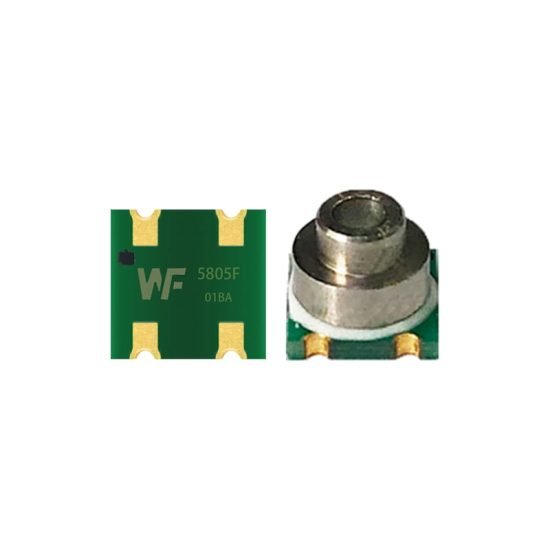Katalog
Depth detection sensors work on the basis of hydrostatic pressure. With compact MEMS devices like the WF5805-05BA, plus sealing and signal electronics, pressure is quickly converted into reliable depth readings. For underwater robots, diving systems and control platforms, these sensors are critical to achieving precise positioning and stable control.
1. Sensor and hardware traits
WF5805-05BA and similar MEMS sensors
The WF5805-05BA is part of a family of high-precision MEMS absolute/relative pressure sensors, usually in small SMD packages with a metal port on top. The silicon element inside is micro-machined for high sensitivity and low temperature drift, while the pins and sealing materials make it reliable in long-term use. These features suit ROVs, AUVs and diving gear where repeatability and linearity are vital.

2. Operating principle and depth conversion
From water pressure to depth
What the sensor measures is static water pressure. The physics is simple: pressure rises with depth, ΔP = ρ·g·Δh. The sensor’s voltage or digital signal is corrected using calibration factors, local density and gravity, then converted into depth. For accuracy, systems also allow for temperature and salinity changes that affect water density, adding those as compensation terms.
3. Packaging, sealing and interface design
Packaging for deployment in the field
A depth sensor for underwater work has to balance pressure tolerance, corrosion resistance and electrical isolation. WF5805-05BA types often use a metal port or isolation diaphragm, sealed with epoxy, in a solder-mount package. Design considerations include avoiding blockage, preventing electrochemical corrosion, and controlling drift over long immersion periods.
4. Data handling, sampling and accuracy assurance
From raw sensor output to usable depth
Accurate depth control depends on sampling stability, clean signal amplification and precise ADC conversion. Key points are choosing a sampling rate that balances bandwidth with filter delay, adding compensation for temperature and salinity, and building error budgets and drift monitoring into firmware. Calibration of zero, span and curve makes sure depth readings stay within engineering tolerance.
5. Precision control in underwater engineering
How sensors improve control and execution
Integrating accurate depth feedback into a control loop boosts the fine-tuning of thrusters and rudders, cutting overshoot and oscillation. For operations like pipeline laying, survey marker positioning or close-to-seabed work, stable sensor readings reduce convergence time and steady-state error. In short, better sensor stability allows tighter gain settings and more robust fault tolerance in controllers.
Abschluss
Depth detection sensors built on MEMS pressure elements, combined with robust packaging and solid data handling, turn water pressure into reliable depth data. For underwater projects, selecting the right device (such as the WF5805-05BA), optimising sealing and interfaces, and enforcing calibration are the foundation of accurate and stable control.
Die obige Einführung kratzt nur an der Oberfläche der Anwendungen der Drucksensortechnologie. Wir werden weiterhin die verschiedenen Arten von Sensorelementen untersuchen, die in verschiedenen Produkten verwendet werden, wie sie funktionieren und welche Vor- und Nachteile sie haben. Wenn Sie detailliertere Informationen zu den hier besprochenen Themen wünschen, können Sie sich die entsprechenden Inhalte weiter unten in diesem Handbuch ansehen. Wenn Sie unter Zeitdruck stehen, können Sie auch hier klicken, um die Details dieser Leitfäden herunterzuladen PDF -Daten des Luftdrucksensorprodukts.
Weitere Informationen zu anderen Sensortechnologien finden Sie hier Besuchen Sie unsere Sensors -Seite.
